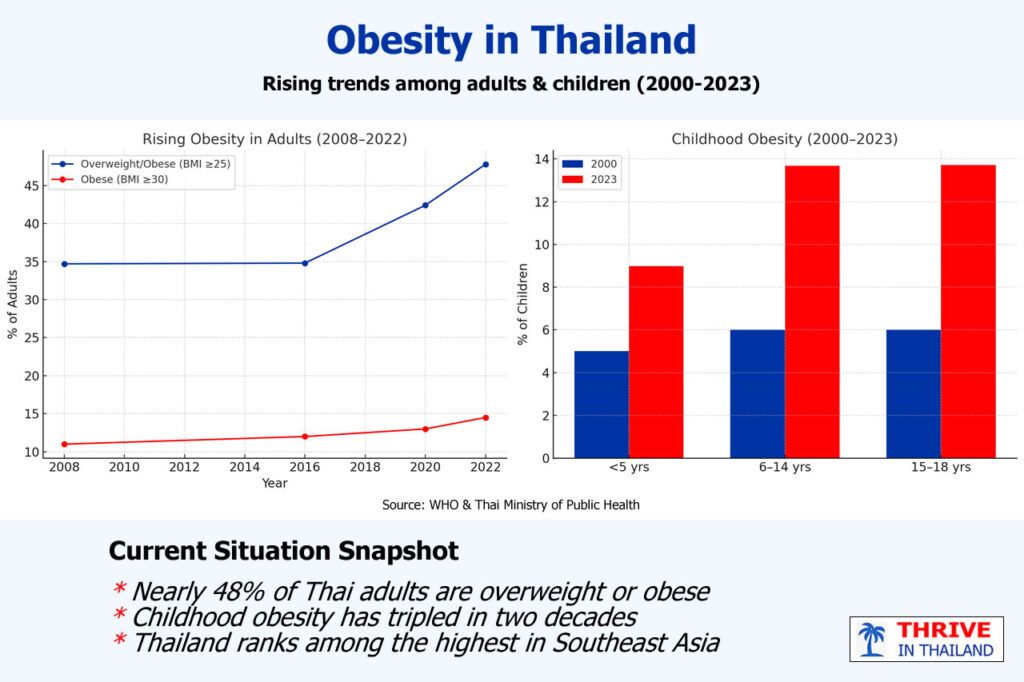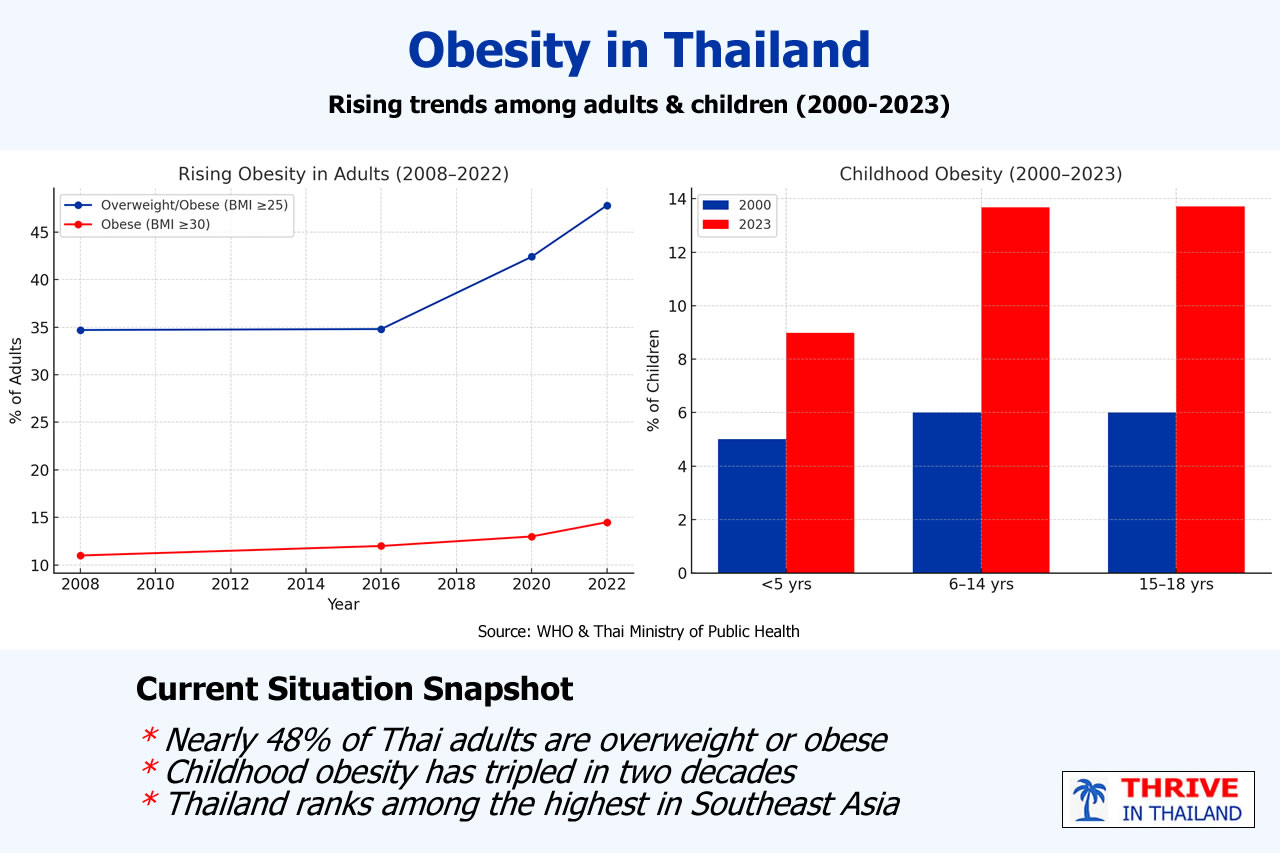
If you’ve ever grabbed a sweet Thai tea from 7-Eleven, snacked your way through a night market, then finished with fried roti and condensed milk, you’ve met Thailand’s delicious dilemma. Thai cuisine has a global reputation for freshness and balance, yet waistlines are growing. The picture is more complex than “Thai food is healthy.” It’s how we live, what we drink, and how modern convenience sneaks sugar and calories into everyday routines.
For expats, the shift can happen quietly. Motorbikes replace walking, work becomes more sedentary, and cheap beers or café drinks become a habit. Add late-night eating, generous portions, and an abundance of processed snacks, and the result is predictable. Obesity in Thailand is no longer a niche public health issue. It touches locals and farang alike, and it shows up in higher risks for diabetes, blood pressure problems, and heart disease.
This guide looks at what is actually happening in Thailand, why it is happening, and what you can do about it without giving up the food you love. We’ll bring in recent data, cultural context, and practical choices that work in real life. Think smart swaps at the market, movement that fits Thai city life, and health checks that won’t break the bank. The goal is simple: enjoy Thailand, stay healthy, and keep the good stuff on your plate.
Current Situation & Statistics
Thailand may be famous for its fresh markets and light meals, but the numbers tell a different story. According to the World Health Organization (WHO) and Thailand’s Ministry of Public Health, obesity rates have been steadily climbing over the past two decades. Overweight is typically defined as a BMI of 25+, while obesity begins at 30+. By either measure, Thailand’s rates are moving in the wrong direction.
- Adults:
Around 10 million Thai adults are considered obese, with nearly one in three adults now overweight or obese. In 2022, 47.8% of Thai adults (BMI ≥ 25) were either overweight or obese, up sharply from 34.8% in 2016. Among working-age Thais (aged 15–59), the rate rose from 34.7% in 2008–2009 to 42.4% in 2019–2020.
- Children:
The problem isn’t confined to adults. Childhood obesity has tripled in the last 15 years, with school-aged rates climbing from 5.8% to 15%—especially in urban areas where fast food and sugary drinks are part of daily life.
- Regional comparison:
Thailand now ranks among the highest in Southeast Asia for obesity prevalence, surpassing neighbors like Cambodia and Laos, though still behind Malaysia and Singapore. WHO data for obesity (BMI ≥ 30) places Thailand’s adult obesity rate at around 14–15%, slightly above the regional average of 10–11%.
- Urban vs rural:
Bangkok, Chiang Mai, and other large cities see much higher rates of obesity compared to rural provinces, where diets remain closer to traditional Thai meals of rice, vegetables, and fish.
📌 In just a generation, Thailand has gone from being one of Asia’s leanest nations to facing an obesity problem that affects millions—and expats who settle here often find themselves caught in the same trends if they’re not careful.
• Nearly 48% of Thai adults are overweight or obese (BMI ≥ 25), up from 35% just a few years ago.
• Around 15% of adults meet the definition of obesity (BMI ≥ 30), one of the highest rates in Southeast Asia.
• Childhood obesity has climbed from 5.8% to 15% in two decades, especially in urban areas.
Causes & Contributing Factors
Obesity in Thailand is not the result of one simple habit but a combination of shifting diets, cultural practices, and lifestyle changes. Together, these factors explain why waistlines are expanding across the country.
- Dietary changes:
Traditional Thai meals are naturally balanced—rice with vegetables, fish, and herbs. But in recent decades, processed foods, fried snacks, and sugary drinks have become a daily staple. Thailand is among the world’s highest consumers of sugar-sweetened beverages, with everything from iced coffee to bubble tea loaded with syrup and condensed milk. Add Western fast-food chains spreading across every city, and the calorie count quickly adds up.
- Cultural habits:
Eating in Thailand is a social affair, and the culture encourages frequent snacking. From night markets to 7-Eleven shelves, cheap and tasty food is available around the clock. Many Thais see sharing snacks or sugary drinks as part of hospitality, so refusing can feel impolite. Combined with a taste for sweet flavors, this cultural norm often tips the balance toward excess calories.
- Lifestyle shifts:
Thailand’s rapid urbanization has also brought more sedentary work. Office jobs and long commutes have replaced farm work and daily walking. Motorbikes are the preferred transport in most towns, meaning short trips that could be walked are now motorized. Add in screen-heavy leisure—social media, gaming, and streaming—and the energy gap widens further.
- Socioeconomic factors:
Rising income levels mean more people can afford convenience foods, dining out, and delivery apps. What was once an occasional treat—fried chicken, pizza, sugary desserts—has become a regular part of middle-class life. Meanwhile, healthy food like fresh fruit and fish has become relatively more expensive in urban areas, especially compared to fast, calorie-dense options.
📌 These combined forces show how modernization has reshaped the Thai diet and lifestyle. The result is a steady drift away from the country’s healthy culinary traditions toward habits that increase the risk of obesity—and it’s a pattern that expats often fall into as well.
• Thais consume over 26 teaspoons of sugar per day on average—more than double the WHO’s recommended limit.
• Food delivery apps like Grab and Foodpanda have exploded in popularity, with orders growing by 40% year-on-year, making calorie-dense convenience meals easier than ever to access.
Health Implications
The rising rates of obesity in Thailand aren’t just a matter of appearance—they come with serious health consequences. Doctors here are increasingly concerned about the surge in lifestyle-related diseases, and the numbers back up those concerns.
- Diabetes and metabolic disorders:
Thailand now has more than 5 million people living with diabetes, and the connection with obesity is undeniable. Excess weight makes it harder for the body to regulate blood sugar, and cases are climbing fastest in urban areas where modern diets dominate.
- Cardiovascular disease:
High blood pressure, heart disease, and stroke are becoming more common as diets shift toward salty, fried, and processed foods. The Ministry of Public Health has flagged cardiovascular illness as one of the country’s leading causes of premature death.
- Healthcare costs: Treating obesity-related conditions places a growing burden on Thailand’s healthcare system. Public hospitals see long queues for diabetes and hypertension clinics, while private hospitals are adapting to demand with lifestyle and weight-management programs aimed at wealthier Thais and expats.
- Impact on quality of life:
Beyond the statistics, obesity reduces energy, limits mobility, and increases the risk of complications from infections and surgery. For expats, this means higher health insurance premiums and more frequent medical check-ups—factors worth considering when planning long-term life in Thailand.
📌 The bigger picture is clear: as waistlines expand, so do the health risks and costs. Obesity is quietly reshaping Thailand’s public health landscape, and it affects both locals and foreigners who call the country home.
• Over 5 million Thais live with diabetes, a figure expected to rise sharply in the next decade.
• Cardiovascular disease is now one of Thailand’s top three causes of death, closely linked to obesity and high blood pressure.
• Treating obesity-related conditions costs the Thai healthcare system an estimated 50+ billion baht annually.
Obesity Among Children & Youth
While adult obesity gets most of the headlines, Thailand is also facing a worrying trend among its younger generations. Childhood obesity rates have more than tripled in the last 20 years, raising alarms about the country’s future health.
- Diet and marketing pressures:
Children are growing up surrounded by cheap, calorie-dense foods. From fried chicken stalls to brightly packaged snacks in 7-Eleven, unhealthy choices are everywhere. Sugary drinks are aggressively marketed, and sweetened milk teas and sodas are often seen as harmless treats.
- School environment:
Although some schools have introduced “healthy canteen” programs, many still sell fried snacks, sugary beverages, and instant noodles. Packed lunches from home can be healthier, but busy parents often rely on convenience foods.
- Screen time and sedentary habits:
Like in many countries, Thai children are spending more time on screens—whether gaming, scrolling social media, or watching videos—and less time outdoors. Urban living also means fewer safe spaces for play compared to rural villages.
- Long-term risks:
Childhood obesity often tracks into adulthood, setting the stage for early-onset diabetes, high blood pressure, and heart disease. This not only affects quality of life but also threatens to put additional strain on Thailand’s healthcare system in the decades ahead.
📌 The challenge is clear: unless children adopt healthier habits early, Thailand’s next generation could face even higher rates of obesity-related illness than their parents.
• Childhood obesity in Thailand has risen from 5.8% to 15% in just two decades.
• Thai children now consume an average of two sugary drinks per day, far above health guidelines.
• Urban children are twice as likely to be overweight compared to those in rural areas.
The Expat Angle
Obesity in Thailand isn’t just a local issue—many expats find themselves gaining weight after moving here. The lifestyle that feels exciting at first can quietly add inches to the waistline.
- Food abundance and temptation:
Thailand makes it easy to eat well, but also easy to overeat. Street food stalls, 7-Eleven snacks, and late-night markets mean meals are available 24/7. Add in cheap beer, sweet cocktails, and sugary iced coffees, and the calories pile up fast.
- Less everyday movement:
Expats often swap walking or public transport back home for motorbikes and taxis. Even in walkable cities like Chiang Mai, convenience often wins, and daily steps drop significantly.
- Social culture:
Eating and drinking are at the heart of Thai social life, and expats are quickly drawn into that rhythm. Bar nights, after-work dinners, and weekend feasts all add to the tally.
- The double edge of Thai food:
Traditional Thai cuisine can be one of the healthiest diets in the world—think som tam (papaya salad) with grilled chicken or tom yum soup. But many popular dishes are loaded with oil, sugar, or coconut cream. Pad Thai, massaman curry, and Thai iced tea are delicious, but not always waistline-friendly if eaten daily.
📌 For many expats, the result is “Thailand weight”—a gradual gain of 5–10 kilos in the first few years. The good news? With mindful choices, it’s entirely possible to enjoy Thai food and culture without sliding into the same obesity trends affecting the country at large.
• Swap sugary Thai iced tea for unsweetened lime soda or plain water with a slice of lemon.
• Pick lighter Thai dishes like som tam with grilled chicken or tom yum soup instead of daily curries or fried rice.
• Build movement into your day—walk short distances instead of always taking a motorbike or Grab.
Government & Social Responses
Thailand’s leaders are well aware of the rising obesity trend, and in recent years the government, schools, and health agencies have launched a mix of policies and programs to curb the problem.
- Sugar tax and labeling:
In 2017, Thailand introduced a tiered excise tax on sugary drinks, with rates increasing every two years to encourage reformulation. Beverage companies have since reduced sugar content in many popular drinks. Nutrition labels and front-of-pack warnings are also becoming more common, though enforcement is still a challenge.
- Healthy school canteens:
The Ministry of Public Health has promoted “healthy canteen” standards to reduce fried foods, sodas, and sugary snacks in schools. While some schools have embraced the model, others still rely on fast-selling, high-calorie options to keep budgets balanced.
- Public health campaigns:
Slogans like “Sweet Enough” (หวานพอดี) and nationwide fitness drives encourage people to cut down on sugar and move more. Local municipalities sometimes organize community aerobics in parks, cycling days, and awareness events tied to World Diabetes Day or National Health Day.
- Private sector and civil society:
Beyond government action, hospitals, NGOs, and even fitness influencers are pushing the message. Private hospitals market weight management and lifestyle programs, while civil groups promote home cooking and traditional diets as healthier alternatives.
📌 While progress is uneven, these efforts show that obesity is now firmly on Thailand’s public health agenda. Still, cultural habits and the lure of cheap, convenient food mean change will be slow—and personal responsibility plays the biggest role.
• Thailand introduced a sugar tax in 2017, with rates increasing every two years to push beverage companies to cut sugar content.
• The Ministry of Public Health promotes “healthy canteens” to limit fried foods and sodas in schools.
• Nationwide health campaigns such as “Sweet Enough” (หวานพอดี) encourage Thais to reduce sugar consumption and get active.
Practical Advice
Staying healthy in Thailand doesn’t mean giving up the foods and experiences that make life here enjoyable. With a few mindful choices, expats and locals alike can keep obesity at bay while still savoring Thai life.
- Choose wisely at mealtimes:
Thailand’s street food scene is diverse, and many dishes are naturally light and nutritious. Opt for som tam (papaya salad) with grilled chicken, fresh seafood, or clear soups like tom yum instead of creamy curries or deep-fried options. Ask for “mai waan” (ไม่หวาน) if you want less sugar in drinks or desserts.
- Watch the drinks:
Sugary teas, coffees, and sodas are major contributors to weight gain. Switching to water, soda water with lime, or unsweetened iced tea can cut hundreds of calories a day without much sacrifice.
- Stay active, Thai style:
Thailand offers plenty of fun ways to keep moving. Join a Muay Thai gym, take yoga classes, cycle through the countryside, or simply make it a habit to walk instead of always relying on motorbikes or Grab. Even community aerobics in public parks are a lively (and very Thai) way to stay fit.
- Leverage affordable healthcare:
Preventive check-ups at private hospitals are relatively inexpensive by Western standards. Annual screenings for cholesterol, blood pressure, and blood sugar can catch issues early and give peace of mind.
📌 In short, enjoying Thailand doesn’t have to come at the expense of your health. A little awareness and balance go a long way in keeping both your taste buds and your body happy.
• Say “mai waan” (ไม่หวาน) when ordering drinks to cut out added sugar.
• Pick grilled meats and fresh salads at markets instead of fried options.
• Join a Muay Thai or yoga class—it’s fitness plus cultural immersion.
Thailand’s obesity problem is real, but it isn’t inevitable. The same country that sells sugary teas on every corner also offers fresh fruit, grilled fish, and active outdoor lifestyles. The choice lies in how we adapt.
For expats, it’s a reminder: living well here means more than visas and housing—it’s about building habits that keep you healthy for the long run. Thailand gives us the tools; it’s up to us to use them.
Thinking about this topic? Let me know your thoughts in the comments. I’d love to hear from you.

